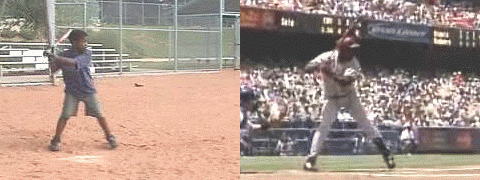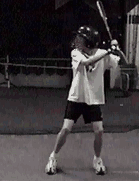Where do you suggest placing the bat while awaiting the pitch? Vertically so that the know points to the ground, or horizontally so that it is nearly restiing on your shoulder?
Original Post
Replies sorted oldest to newest
quote:That's one of the base reasons 45 is a good starting point for younger hitters as they still don't really have that ability to compensate as well yet.
quote:As a player advances towards middle and high school, most start moving the bat more vertical as the ability to handle the lower half of the strikezone becomes more important and the game gets quicker.
quote:More advanced players have the ability to adjust the plane of the bat quickly and can get away with more style variation.
Good point to look for, but is this a cause or effect?quote:Originally posted by S. Abrams:
If a younger player likes a horizontal position, just make sure he doesn't chicken-wing the lead elbow to where it is higher than the back elbow....way too many problems there to even want to discuss.
quote:.......they'll need to be taught bat plane and handling different parts of the strike zone by only torquing the handle.
quote:Originally posted by Michael'sDad:
I have to say that for LL 45 degrees is a good starting point. At that level the strike zone can vary greatly from ump to ump and you have to be able to hit the high pitch as well as the low pitch.
However, as you progress up the ladder I personally feel that you have to go more vertical at each step and almost vertical when you reach the Majors. My reasoning is that the strike zone continues to get lower until it reaches the belt in the Majors and to hit the low inside pitch at the knees you have to start almost vertical. Take a look at most good MLB hitters and they almost all start almost vertical.


quote:Originally posted by BlueDog:
One powers with the shoulders and hands go horizontal together.......
Another:

quote:Originally posted by BlueDog:
If the hands power and do the torquing actively, the bottom hand will get to horizontal before the top hand........
quote:Originally posted by S. Abrams:
bbdoug,
See why I hate the word torque.
My assessment of BlueDog's torque or what I think he's calling torque is the rotation of the bat that occurs as the back elbow is going to the slot position as the top hand is working it's way under the bat to eventually match the bottom hand in a horizontal position. If that ain't it, get a GPS cause I'm lost. If he's calling torque what Mankin calls torque then then we have a huge language barrier.
You mention #5's pictures...I agree with you that there is no way the hands are the main engine/power of the swing. But the hands are important in controlling the power the core generates and timing how the power is released. See some kids that are so focused on core rotation they simply let the shoulder/arms/hands get carried along for the ride....just a dead swing.
I tend to encourage hitters to think hips and hands firing/moving together at the start of the swing. Back hip and hands will look like their joined as they move in unison with the hands passing the back hip as they approach the hitting area ( yeah, that's a vague description that probably doesn't make sense...look at Ortiz and #5, that may help see what I'm trying to say). I don't want them to think hands specifically...more like moving the backside of the body together.
Can anyone translate Greek because we're heading there...
quote:Originally posted by BlueDog:
Connecting the hands and arms to the shoulders and allowing the shoulders to power the swing produces torque.....
Bypassing the shoulders and allowing the hands to power the swing produces torque.....
But, each of these torques has a different effect on the path of the bat.....How the torque is produced is important......It makes a difference in the swing..........
If the shoulders power, the hands go horizontal together.....
If the hands power and do the torquing actively, the bottom hand will get to horizontal before the top hand........
quote:I agree with you that there is no way the hands are the main engine/power of the swing. But the hands are important in controlling the power the core generates and timing how the power is released.
quote:Originally posted by ShawnLee:quote:Originally posted by BlueDog:
Connecting the hands and arms to the shoulders and allowing the shoulders to power the swing produces torque.....
Bypassing the shoulders and allowing the hands to power the swing produces torque.....
But, each of these torques has a different effect on the path of the bat.....How the torque is produced is important......It makes a difference in the swing..........
If the shoulders power, the hands go horizontal together.....
If the hands power and do the torquing actively, the bottom hand will get to horizontal before the top hand........
bluedog,
How exactly do the hands go horizontal at different times? Are they not both holding on to a relatively rigid object that should cause them to achieve the same orientation at the same time? Regardless of whether you participate in the mythical shoulder bypass or not.
quote:Look at the kids...hands first move is down and not forward. Hands never catch up to hips entering the hitting zone. Serious bat drag with rear elbow leading the hands.
quote:Saw the clips of Bonds and Williams...I'll stand by the verbal cue for a rotational swing. Hands and hips are moving together in those clips with hands loading with the stride.
quote:Originally posted by powertoallfields:quote:Originally posted by ShawnLee:quote:Originally posted by BlueDog:
Connecting the hands and arms to the shoulders and allowing the shoulders to power the swing produces torque.....
Bypassing the shoulders and allowing the hands to power the swing produces torque.....
But, each of these torques has a different effect on the path of the bat.....How the torque is produced is important......It makes a difference in the swing..........
If the shoulders power, the hands go horizontal together.....
If the hands power and do the torquing actively, the bottom hand will get to horizontal before the top hand........
bluedog,
How exactly do the hands go horizontal at different times? Are they not both holding on to a relatively rigid object that should cause them to achieve the same orientation at the same time? Regardless of whether you participate in the mythical shoulder bypass or not.
Please look at the slow motion clip of Ortiz. If you do you will see that his bottom hand is moving horizontally before the bat is horizontal and therefore the top hand. Yes, I thought that was impossible too awhile back.
quote:Originally posted by bbdoug:quote:Saw the clips of Bonds and Williams...I'll stand by the verbal cue for a rotational swing. Hands and hips are moving together in those clips with hands loading with the stride.
I'm with you S.Abrams. The swing is an explosive move with the upper body and hands moving as a unit, that begins at foot plant.
quote:Originally posted by S. Abrams:
powertoallfields,
Thinking hips and hands is what I want them to think as a verbal cue. Look at the picture of Ortiz and #5. If the seperation is good, the hands already are behind the hips and have to catch up. Nothing happens as far as the hips until the left heel plants.Hands do not release at the start of the swing. Look at Vlad's swing; he is not releasing the bat towards the ball at any point in that clip. If he releases the bat to start the swing, he would not be able to ever check swing. His hands are starting at the same time the hips and are playing catchup. Wrist **** is still present while he moves the barrel on plane; some wrist **** is lost during seperation but bat is not released.
Look at the kids...hands first move is down and not forward. Hands never catch up to hips entering the hitting zone. Serious bat drag with rear elbow leading the hands.
Read too much from Chameleon...throwing and hitting...great advice for slow pitch softball or the batting cage.